Confluence vs PBWorks
May 17, 2023 | Author: Adam Levine
29
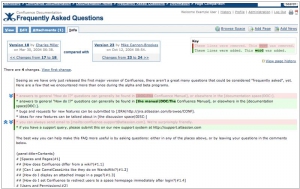
Confluence provides one place for technical teams to collaborate—create, share, and discuss your ideas, files, minutes, specs, mockups, diagrams, and projects. A rich editor, deep Office and JIRA integration, and powerful plugins help teams collaboratively develop technical docs, intranets, and knowledge bases.
1
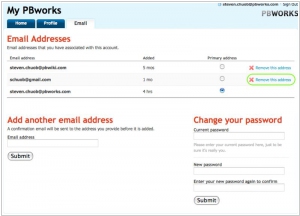
PBworks lets your team capture knowledge, share files, and manage projects. It tracks every change, and automatically notifies you and your team to keep everyone in the loop. PBworks is secure, reliable, and accessible from any computer or mobile device, so your team can use it anywhere they go. You can even use it with clients or partners. And because it's hosted, you don't need to download any software or manage any servers. Whatever you're working on, you can customize PBworks to make your team more productive.
Confluence and PBWorks are both collaboration and knowledge management tools, but they have distinct differences in their features and approach. Confluence, developed by Atlassian, is a robust and widely-used enterprise wiki platform that focuses on creating, organizing, and sharing knowledge within teams and organizations. It offers features like wiki pages, document collaboration, content creation templates, and integration with other Atlassian products. Confluence provides a centralized knowledge base for teams to capture and collaborate on information effectively. On the other hand, PBWorks, formerly known as PBWiki, is a collaboration tool that emphasizes wiki-style content creation and team collaboration. It offers features like wiki pages, project spaces, document collaboration, and project tracking. PBWorks is geared towards creating a centralized knowledge base and facilitating collaboration through wiki-style content.
See also: Top 10 Wiki software
See also: Top 10 Wiki software
Confluence vs PBWorks in our news:
2023. Atlassian brings an AI assistant to Jira and Confluence
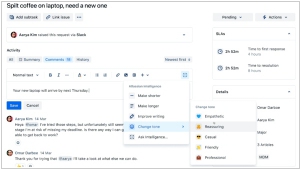
Atlassian has introduced Atlassian Intelligence, an AI-powered 'virtual teammate' that utilizes the company's proprietary models and OpenAI's large language models to create customized teamwork graphs. This technology enables various functionalities, such as AI-generated summaries in Confluence and test plans in Jira Software, as well as the rewriting of responses to customers in Jira Service Management. Atlassian Intelligence provides users with a chatbox similar to Chat-GPT, which is deeply integrated into different products and allows for the referencing of specific documents. For instance, to generate a summary of action items from a recent meeting, users can link the document with the transcript and request the summary inside Confluence. The tool then generates a list of decisions and action items from the meeting.
2021. Atlassian peps up Confluence with new graphical design features
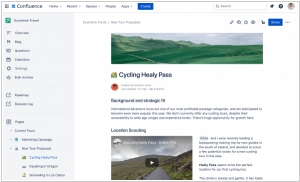
Confluence, the collaborative workspace developed by Atlassian, has been a staple knowledge-sharing tool for over 15 years, widely adopted by companies for its versatility. In its latest update, Confluence introduces several new features to enhance user experience. Users can now customize their spaces with cover images, title emojis, and personalized avatars that represent different sections of Confluence. The addition of smart links allows for seamless integration with platforms like YouTube and Trello, automatically recognizing and displaying links in their native formats. Furthermore, users can schedule the publication of new pages and convert pages into blog posts, reflecting the increasing popularity of corporate blogging within organizations, particularly for internal audiences during the pandemic.
2020. Atlassian’s Confluence gets a new template gallery
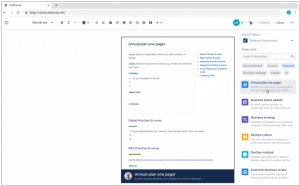
Confluence, the content-centric collaboration tool by Atlassian, is simplifying the onboarding process for new users through the introduction of an enhanced template gallery, featuring 75 additional templates. This update signifies the evolution of Confluence from a specialized wiki primarily used by technical documentation teams to a widely adopted tool utilized across various organizations. The revamped template gallery offers improved search tools, filters, and previews conveniently located in the right-hand panel of your Confluence site. These enhancements facilitate the seamless discovery of templates that are most relevant to your business needs.
2014. Atlassian launches JIRA and Confluence for large companies
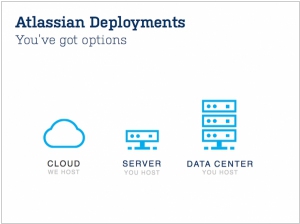
Atlassian has unveiled two new products designed specifically for large enterprises. In the upcoming week, Atlassian will release JIRA Data Center, a version of its project management software that supports running the service on multiple nodes. Additionally, later this summer, it will introduce Confluence Data Center, a collaboration service centered around wikis. With the Data Center versions, larger companies will enjoy improved support for scaling the services across multiple nodes, resulting in enhanced performance and scalability. Administrators will have the ability to route specific applications, teams, or geographies to designated nodes within a cluster, while additional nodes can be added in real time. The clustering technology and shared file systems are seamlessly integrated with industry-standard technologies, ensuring smooth operations.
2011. JIRA, Confluence available as SaaS services
Atlassian has launched the new SaaS service Atlassian OnDemand, which includes its popular tools for managing software development projects: JIRA (issue-tracker), Confluence (wiki), GreenHopper (Agile Project Management), Bonfire (bug reporter), FishEye (code manager), Crucible (code review) and Bamboo (integration). All products in the SaaS version provide the full functionality of the installable counterparts. There are only minimal restrictions on the tool integration and use of the custom plug-ins. You can turn on/off the tools as needed. The service pricing is traditional for Atlassian - "everything for $10 for 10 users." Recall that the company is also selling the 10-user leniences of the same installable products for $10. So you can either buy the product for $10, or rent it for $10/month. ***
2009. PBWorks - business wiki in real-time
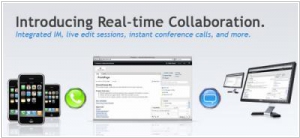
Today we more and more often hear the new term - "unified collaboration". This is the new logical step after "unified communications" and means that collaboration and communication tools are integrated. The pioneer in this movement is PBWorks (formerly PBWiki) - an enterprise wiki service. Today they announced four new features for communications and collaboration in real-time: messenger, live notifications, real-time, editing, voice conferencing. Interesting, that after that PBWorks positions itself, as the Google Wave alternative. But, while Google Wave is an attempt to re-think the concept of individual communication, PBWorks is built around corporate networks and project workspaces, and ***
2009. PBworks incorporates project management
PBworks has introduced PBworks Project Edition, a modified version of its collaborative online wiki software that integrates project management features. The tool incorporates simple project management functionalities, including workflow management, task assignment, and milestones, eliminating the need for a separate application like Basecamp. This integration makes PBworks an appealing choice for teams seeking a collaborative tool for project-related tasks such as document creation, requirements gathering, or design review. Task management is seamlessly integrated with the tasks themselves, providing a logical and efficient approach. PBworks Project Edition is priced at $20 per user per month, while "guest" licenses, intended for clients and contractors involved in a specific project, are available free of charge.
2009. Atlassian announced Confluence 3.0 and Plugin Exchange
Atlassian has announced the release of Confluence 3.0, an upgraded version of their enterprise wiki platform, with a strong focus on enhancing the social networking aspects. The new release introduces activity streams and Twitter-like status updates, marking a significant advancement for Atlassian. Users can now post status updates of up to 140 characters and choose to follow their colleagues' updates selectively or subscribe to entire activity streams through the web interface or RSS. While personal profiles and status updates are not groundbreaking in the realm of social software, these features enhance collaboration and communication within Confluence. Additionally, Atlassian has introduced the Plugin Exchange, a marketplace where users can download, rate, and review numerous third-party plugins. With this centralized site, Atlassian aims to create a more community-driven marketplace for Confluence plugin developers. As part of this initiative, Atlassian has acquired GreenHopper, an agile project management plugin for their JIRA issue tracking software, further complementing the launch of the Plugin Exchange.
2009. PBwiki targets business users with a new name
PBwiki has rebranded itself as PBworks to better align with its expanded offerings and functionalities beyond a traditional wiki platform. With a revamped user interface and enhanced features introduced last year, PBworks now provides businesses with a customizable wiki workspace that includes mobile support, document management, access controls, and more. In addition, the company plans to launch a new project management application in the coming months. PBworks has also introduced a specialized "Legal Edition" that combines wiki functionality with case management features, offering a legal knowledge base and an electronic deal room for efficient file management by legal professionals. With a strong client base that includes teams from over a third of the Fortune 500, as well as prestigious institutions like the United Nations, The Financial Times, and Harvard University, PBworks has gained a loyal following. Similar to Salesforce, PBworks operates on a paid subscription model, ensuring an ad-free experience for its users.
2009. Confluence gets widgets from Widgetbox
Widgetbox has recently made its widgets compatible with Atlassian Confluence, a business wiki solution. By "componentizing" applications, Widgetbox widgets offer the ability to easily transfer and utilize them across various websites. This integration allows users to seamlessly incorporate Confluence into their workflow, simplifying the management of news feeds and data from other sites. The collaboration between Widgetbox and Confluence serves as a valuable addition behind the enterprise firewall, enhancing the functionality of Atlassian's utilitarian applications. With Widgetbox, users can go beyond the limitations of customization and integration with external applications and data, overcoming the obstacles that were previously encountered.



